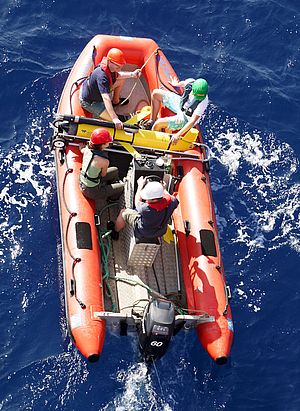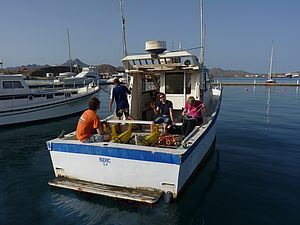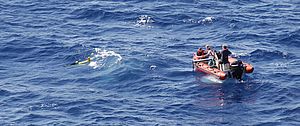The youngest group of oceanographic instruments is characterized by their operation being largely independent from oceanographers and research vessels. Floats, Gliders and AUVs (Autonomous Underwater Vehicle) are the logical development of several decades of oceanographic instruments. They combine sensors that have been in use for many years in moored systems (see e.g. MicroCats) with a mobile platform.
Because of this mobility measurements can be performed not only in a single location but can now cover larger areas.
Floats, Gliders and AUVs differ fundamentally in their propulsion systems.
While floats are carried by ocean currents without any external control, AUVs and Gliders can independently move through the oceans. AUVs are driven by a conventional propeller and are characterized by their high speed and good controllability. Gliders however, have no propellers and can only move at relatively slow speed through the oceans (about half the speed of a pedestrian). Gliders share their ingenious propulsion system with floats. A high pressure pump can move oil from the interior of the pressure housing of the devices into a bubble outside of the housing and back. Thereby float and glider are able to change their density and similar to a submarine they move up and down in the water column.
While the float uses this vertical movement only to gain measurements over the entire depth range, gliders convert the vertical into an additional forward movement similar to the principle of a paper airplane.
All three new observation platforms share batteries as their energy supplier.
Their range is therefore limited. Because of their different propulsion systems differing andcomplementary measurement strategies are employed. On a single battery charge AUVs can for example travelfor one day along a pre-programmed up to 200 km long track. Gliders move, however, much slower and more economical in terms of their battery usage. Their deployments can last up to several months and the distance they cover can be well above 2000 km. Floats on the other hand are the energy saving champion.
They travel the oceans for up to 5 years. During this time they are carried along with the ocean currents and can therefore, depending on these highly variable flows, travel thousands or just a few dozen kilometers.
Another common feature of these three devices is their basic design as a sensor platform.
Depending on the research requirements and the availability a large variety of sensors can be installed.
For floats the number of different sensors is, due to their long life spans and low energy reserve, still quite very limited. In addition to the standard oceanographic sensors for temperature and salinity, more recently, oxygen and carbon dioxide sensors have been developed and deployed. Gliders have so far been used as platform for current meters, chlorophyll and turbidity sensors, and hydrophones with which marine mammals can be monitored. AUVs are, because of their short deployment duration and their relatively large energy reserves, much less limited in the possibilities of installable sensors. They can for example be equipped with energy-hungry multibeam echo sounders and with their help precisly map large swaths of sea floor.





